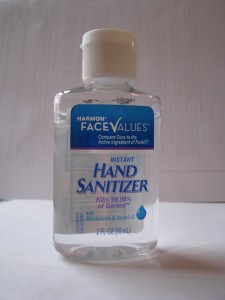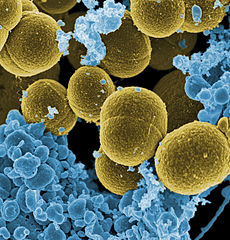How Does Hand Sanitizer Work?

Hand Sanitizer Effectiveness on Bacteria and Viruses
It's barely October and like many poor souls who work with children I've already had my first round of a flu-like virus. It's nearly impossible to avoid when you have hundreds of kids coming through, coughing, sneezing, wiping their hands on their noses, and generally being boogery without even consciously thinking about spreading germs. When I visited my doctor one thing she suggested was using a lot of hand sanitizer along with hand washing. So that started me wondering, how does hand sanitizer work? And, how effective is hand sanitizer on viruses and bacteria?
Of all the literature I've reviewed the general consensus is that hand washing is the most effective way to remove large particulates, dirt, feces, ecoli, and other materials from the hands. This means washing for about 20 seconds, in warm water and using plain soap. As an outdoor educator I know that this isn't always feasible when outside or between activities.

BACTERIA V. VIRUS
First, let's look at the differences between bacteria and viruses.
Bacteria |
Virus |
| Microscopic | Sub-microscopic |
| Living | Non-living |
| Single celled | Non-cellular |
| Cell wall made of fatty lipids | Only SOME have external protein envelope |
| Have core genetic material and proteins | Have core genetic material |
| Can reproduce by itself (has its own protein machinery to reproduce) | Can't reproduce without host cells, invade other cells to reproduce (need the proteins and machinery of other cells) |
| Feeds | Does not feed |
| Excretes waste | Does not excrete waste |
| Grows | Does not grow |
So basically the big difference between bacteria and viruses is that one is alive and one isn't. Bacteria can reproduce on their own and viruses need a host. Also key is the external envelope or membrane of each. Bacteria have an envelop of fatty lipids and viruses may or may not have an external envelop made of protein.
So, how does this relate to hand sanitizers? First, most hand sanitizers are made of alcohol. The National Institute of Health and FDA suggests that, "To reduce infections in healthcare settings, alcohol-based hand sanitizers are recommended as a component of hand hygiene (4). For alcohol-based hand sanitizers, the Food and Drug Administration (FDA) (5) recommends a concentration of 60% to 95% ethanol or isopropanol, the concentration range of greatest germicidal efficacy." (note: avoid any hand sanitizers with less than 60%). Alcohol is the key driver, and is used to kill bacteria by:
1. Breaking down the fatty lipid (and water) coating around the bacteria, exposing the insides of the bacteria to the alcohol.
2. Denaturing the protein "machinery" inside the bacteria's cell, so that the bacteria essentially falls apart and can't function.

Ok, so we know about bacteria, but what about the dreaded virus? Viruses are big "moochers" because essentially they're just packets of DNA floating around that need the machinery of other cells to function. Think of them like seeds of DNA with a seed coat and nothing else. When they find a suitable host cell they insert their DNA, infect the cell, clone their own DNA, and then the host cell ruptures out copies of the virus DNA and so forth.
The alcohol in hand sanitizer can work against SOME viruses, especially those that have a protein coating, like influenza or H1N1 viruses. The alcohol denatures the protein envelope and renders them ineffective. However, there are many viruses, like norovirus (the one that most commonly infects food and food handling areas..think food poisoning) that are not affected. This is also true of things like protozoa born illnesses such as malaria. This "some" factor, of viruses having protein coats or not, means that hand sanitizer is not always the best tool to prevent the spread of viruses.
HAND SANITIZER V. ANTIBACTERIAL SOAP
So how does hand sanitizer compare to antibacterial soap? Well, here's the upshot. Antibacterial soap can kill some bacteria, but unlike the hand sanitizer it does not evaporate rapidly. Because the hand sanitizer evaporates rapidly it allows for the "good" bacteria to recolonize your skin fairly quickly, and does not allow for the "bad" bacteria to gain resistance by "hanging around" on your skin. Unfortunately, antibacterial soap lingers on the skin and provides grounds for bacteria to become resistant.
The key thing to remember about hand sanitizer is that it's fast acting and short lasting. Antibacterial soap is fast acting and long lasting, but this may not be for the better because of antibacterial resistance.
Your best best is a combination of tools. Use plain old soap and water when you have visible soiling of hands or body parts, and hand sanitizer when you're between bathroom breaks and need a quick defense against germs (hallways, offices, forests, picnic areas, desk, etc). For outdoor educators and researchers, hand sanitizer is a good option if water is not nearby. It's also important to remember to keep rubbing when you're applying hand sanitizer. If you don't rub it around then you're not really getting rid of the bacteria and those viruses that are susceptible to the alcohol. Keep rubbing across the entire surface of your hands, fingers, and nails until it evaporates.
If you'd like an "in-depth" and nerdy dive into hand health care (and how hand sanitizers work, check out the World Health Organization guidelines on hand-hygene. It's 270 pages of hand-germy-goodness.


